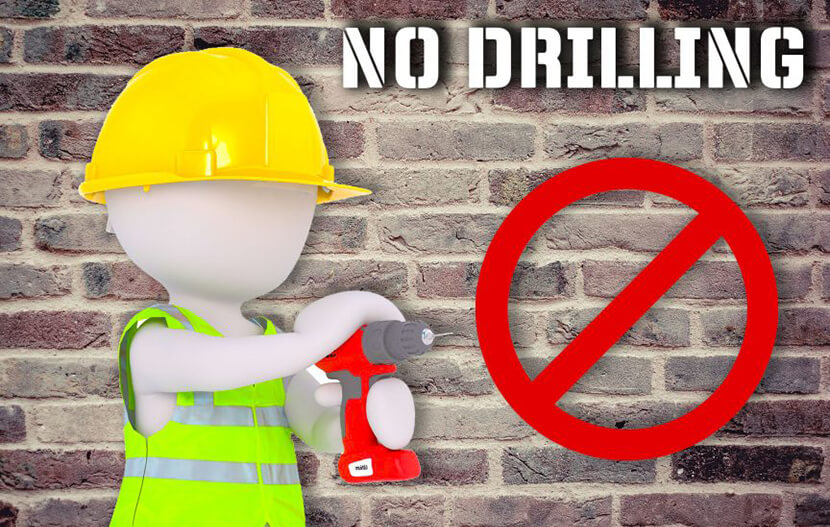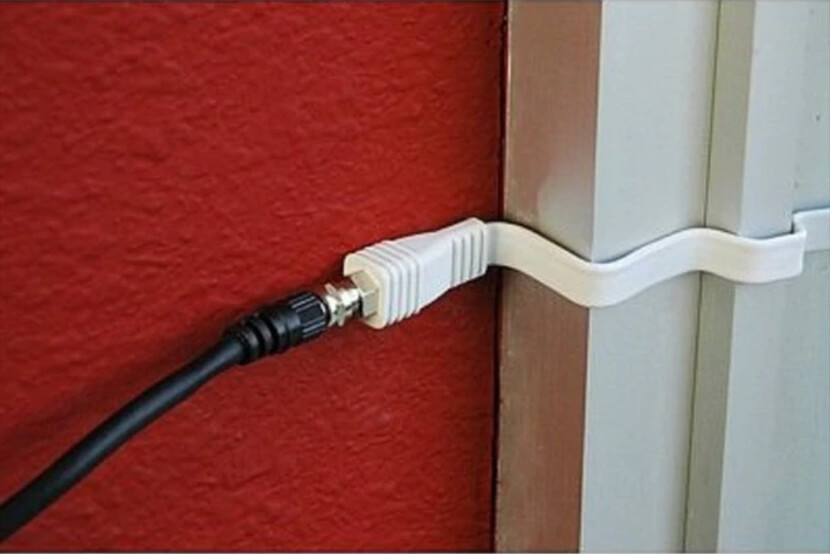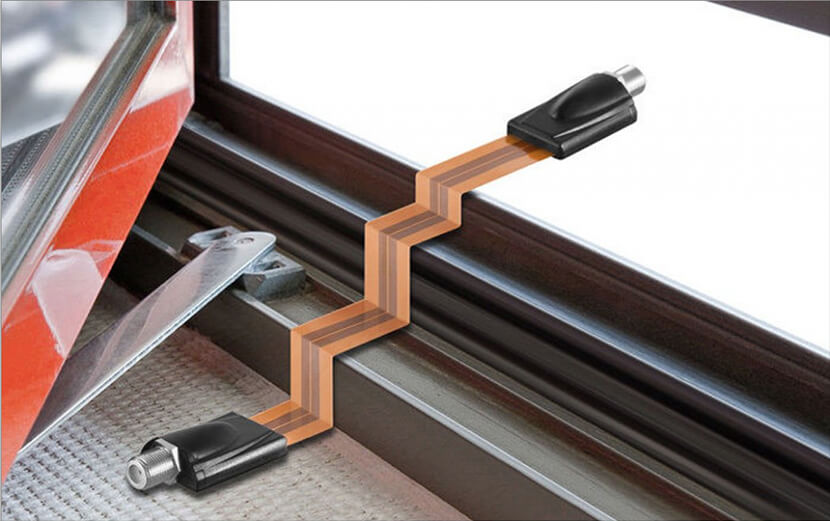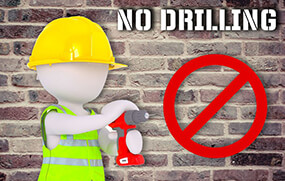
Routing cables for a TV or home entertainment system can be tricky at the best of times. However, running wires without drilling holes through external walls further complicates the job. Fortunately, flexible flat coax cables make the job easier. These allow you to pass wires through the narrow spaces around door or window frames without any significant effect on signal strength or impeding the closing of the window or door.
Whether you have a rented apartment or an RV where you either can’t or don’t want to drill holes. Or you want a temporary solution while settling into a new place. The most straightforward answer to route your TV cable without any drilling is a flat coax cable coupler. These will work for most signal applications, either OTA (over the air) TV, radio and will carry HDTV signals provided via DISH or DirecTV satellite dishes without noticeable loss of signal.
A tightly woven wire mesh covers the signal carrying copper core to protect it from interference. A dielectric cladding material separates the two conductors. The ends of the coax lead ground through crimped RG-6 or F-Connectors.
Routing your TV cable
Not being able to drill holes means longer cable runs are inevitable. Especially if you need to find a convenient opening to feed your wiring. If you are running a new RG6 coax from either a satellite dish or antenna mounted outside first locate the nearest window or door to your TV or home entertainment system. Then run the coaxial cable to it using cable clips either hammered or screwed into the external wall. Flat coaxes should ideally be fitted through an infrequently used window or door to avoid excessive wear and tear. Generally, these cables are between 8″ to 12″ long, which is more than adequate for most applications.
If there is an adequate gap through the external window/door (i.e., older windows will usually have more significant gaps around the frame) it is best to fit flat coax jumper cables with slightly more insulation and shielding. The Holland Electronics DISH & DirecTV Flat Coax Cable has additional shielding which makes them thicker but also more durable than the much thinner flat coax cables like the Ghost Wire Flat RG6 Coax Jumper Cable. Wherever possible I would always opt for the more heavily insulated version. They tend to have better shielding

But wait…tight frames cut cables!
Although most flat coax cables easily fit in the gap of a typical double pane apartment window, closed. Check to see how tightly your window/door shuts before installing the cable. It could be an expensive mistake to scissor it in half with a tightly fitting window. Be aware of expansion of frames in summer, as they can swell in humid conditions and crush the cable.
And…watch out for shorts!
It’s important to note that some satellite systems send a DC voltage down the coax to power the electronics at the dish. If the gap isn’t adequate, it is possible to have a short circuit which could damage your receiver.
An inexpensive in-line coaxial surge protector can help protect your cable box, satellite receiver or other devices from power surge problems. Lightning strikes or unexpected power surges can damage equipment traveling along coaxial cable in the blink of an eye.
Security issues of feeding cables through windows
Be wary not to provide any potential burglar with an opportunity to prise open a window or door. When installing your flat coax cable make sure you can close and lock the window or door. Don’t file or cut away too much of the frame giving access to a pry bar!
Do flat coax cables affect signal strength?
As with any cable carrying a signal the number of connections will affect overall signal strength and quality. Signal loss of these specially designed cables does not degrade with bending, impact or temperature changes. If you live in a bad signal area, you may want to test this before you take the plunge. Fit your cable loosely before clipping and sticking.
When installing satellite or OTA systems, you need to create a strong chain between the transmission and receiver. Every link needs to be as good as possible including the coaxial connecting the TV to the satellite dish or antenna.
An extremely high-frequency electrical carrier wave transports the data between your dish/antenna and interface receiver. Due to its high frequency, it is highly susceptible to signal degradation, RF interference, and attenuation over long distances.
If interference enters the coax, it is converted to electricity and transferred to
Satellite signal strength meters are ideal for checking the signal. Alternatively, plug into your satellite receiver box and test the signal strength shown in the settings. It is also a good tip to avoid any sources of interference such as fridges or other unsuppressed devices.
Fitting the flat coax cable
Fit the jumper cable when you are happy that you can safely install the wire through the gap around your window or door. Flat coax cables usually come with double sided sticky tape to keep them in place. To install, open the door or window that you want to pass the wire through and before removing the self-adhesive backing. Place the flat coax in position, bending and forming it to the shape of the opening. For extra protection, you could also add some aluminum tape over the top, particularly over heavy wear spots.

Flat cable couplers use standard RG6 / F-connectors — the same as the connectors used on most satellite installations. You may need to invest in an F-connector crimping tool if you’re using a reel of RG6 coax rather than pre-terminated cables.
Other methods of hiding coax cables
Once your coax is indoors, you still have to get it to your cable box, OTA or Satellite receiver. Connect the internal coax cable to the flat coax F-connector (you might consider using white coax once inside the room if this will blend in better with the décor!). Cables can be clipped along skirting boards. Or alternatively, hidden in self-adhesive trunking. Exposed cables can be unsightly, plastic trunking hides wires neatly, perfect if you are avoiding drilling holes inside as well!
If you don’t want to use trunking or clip cables to the skirting, then it is possible to lay ultra-thin coax under a carpet which is virtually invisible. You don’t need any special tools to do this, all that’s required is a fish cable or a flat tape measure. Ultra-thin coax can be obtained in lengths up to 25 ft.
Wherever possible try and minimize cable runs and stick to running the cable up against a wall, where it will be inconspicuous, rather than across the main walkway. There may be a divot near the wall that will make it easy to hide your cable. No matter how thick the carpet you’ll always notice a lump if routing across visible areas. You’ll also want to avoid creating trip hazards.
Interior use of flat coax cables
To run cables around internal door frames, you can use another flat coax cable laid at a low level. Avoid putting the wire under heavy furniture or where it could be stepped on, to prevent signal problems caused by a crushed cable.
If you have wood paneling, you could try prying the sheets out slightly to tuck wires behind. Another solution is to create false wall panels. These take more work but can give much more pleasing results – especially if you have a lot of wires to hide. You can build a small frame with wood paneling, painted to match your room, placed in front of the cable run.
Once the cable is in place, you can connect it to the back of your receiver via an F-connector. Alternatively, it can be terminated to a surface mount satellite socket or wall plate.
Alternatives to an external TV antenna or satellite dish
Of course, you can always use an internal antenna system, there are some good ones on the market. If you don’t live in a strong signal area the signal received can be “night and day” different when compared to an external antenna solution. To get the best signal possible try using one of these flat coax cables and put the antenna outside. You’ll be surprised by the difference!

